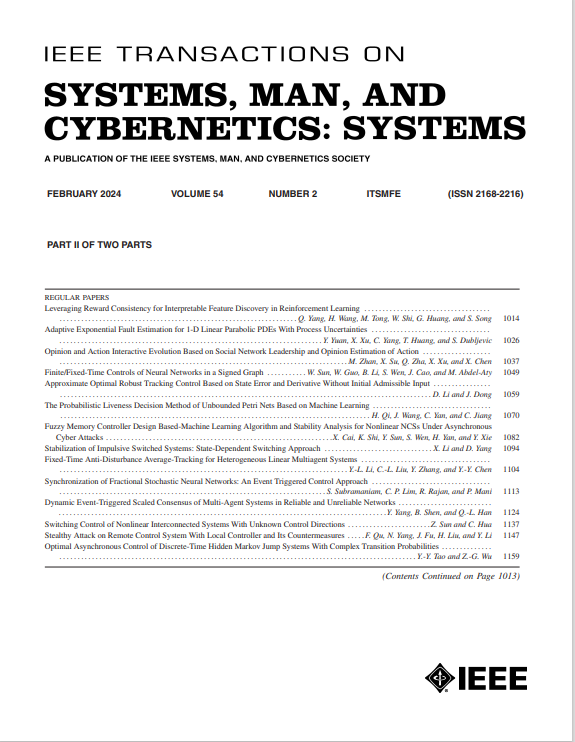Back to the Future: Synergizing Fuzzy and Conventional Control
IF 8.6
1区 计算机科学
Q1 AUTOMATION & CONTROL SYSTEMS
IEEE Transactions on Systems Man Cybernetics-Systems
Pub Date : 2024-11-28
DOI:10.1109/TSMC.2024.3502446
引用次数: 0
Abstract
This study revisits the fuzzy control system design problem with the motto “Fuzzy with Conventional Control,” inspired by L.A. Zadeh’s statement in the famous debate “Some Crisp Thoughts on the Fuzzy versus Conventional Control.” Focused on single-input (SI) fuzzy PIDs (FPIDs), our approach synergizes fuzzy and conventional control, presenting similar control laws to PID and fuzzy gain-scheduled (FGS) PID. Departing from traditional fuzzy control paradigms, our design methodology enhances, rather than replaces, PID controllers with fuzzy logic controllers (FLCs). We start by analyzing the internal structure of both type-1 and type-2 SI-FPIDs and commenting on their structural properties. We address the high-design complexity of FLCs by proposing an interpretable and geometrical design method that explicitly shapes fuzzy mapping (FM) according to the desired control characteristics. To provide self-tuning (ST) capability to the FPID, like the FGS-PID, we develop ST mechanisms that adapt the FM of SI-FPID according to the operating point via the derived insights. Real-world application in speed control for an industrial permanent magnet synchronous machine validates the efficacy of our designs, showcasing improved disturbance rejection and reduced control signal variation compared to FGS-PIDs and PID. This research advocates for the wider adoption of SI-FPID as a practical enhancement to PID in industrial applications, offering design simplicity and ST capabilities.回到未来:模糊控制与传统控制的协同
本研究以“模糊与传统控制”为座右铭,重新审视模糊控制系统的设计问题,灵感来自L.A. Zadeh在著名辩论“模糊与传统控制的一些清晰思考”中的陈述。针对单输入(SI)模糊PID (FPIDs),我们的方法将模糊控制与传统控制相结合,呈现出与PID和模糊增益调度(FGS) PID相似的控制规律。与传统的模糊控制范例不同,我们的设计方法是用模糊逻辑控制器(flc)增强而不是取代PID控制器。我们首先分析了1型和2型SI-FPIDs的内部结构,并对它们的结构特性进行了评论。我们通过提出一种可解释的几何设计方法来解决flc的高设计复杂性,该方法根据所需的控制特性显式地形成模糊映射(FM)。为了给FPID提供像FGS-PID一样的自调谐(ST)能力,我们开发了ST机制,通过衍生的见解根据工作点调整SI-FPID的FM。在工业永磁同步电机速度控制中的实际应用验证了我们设计的有效性,与fgs -PID和PID相比,显示出更好的抗干扰性和更少的控制信号变化。本研究提倡更广泛地采用SI-FPID作为工业应用中PID的实际增强,提供简单的设计和ST功能。
本文章由计算机程序翻译,如有差异,请以英文原文为准。
求助全文
约1分钟内获得全文
求助全文
来源期刊

IEEE Transactions on Systems Man Cybernetics-Systems
AUTOMATION & CONTROL SYSTEMS-COMPUTER SCIENCE, CYBERNETICS
CiteScore
18.50
自引率
11.50%
发文量
812
审稿时长
6 months
期刊介绍:
The IEEE Transactions on Systems, Man, and Cybernetics: Systems encompasses the fields of systems engineering, covering issue formulation, analysis, and modeling throughout the systems engineering lifecycle phases. It addresses decision-making, issue interpretation, systems management, processes, and various methods such as optimization, modeling, and simulation in the development and deployment of large systems.
 求助内容:
求助内容: 应助结果提醒方式:
应助结果提醒方式:


